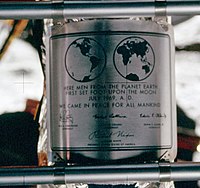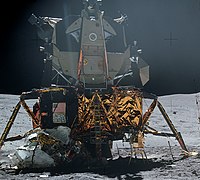
Apollo 11 was the American spaceflight that first landed humans on the Moon. Commander Neil Armstrong and Lunar Module Pilot Buzz Aldrin landed the Apollo Lunar Module Eagle on July 20, 1969, at 20:17 UTC, and Armstrong became the first person to step onto the Moon's surface six hours and 39 minutes later, on July 21 at 02:56 UTC. Aldrin joined him 19 minutes later, and they spent about two and a quarter hours together exploring the site they had named Tranquility Base upon landing. Armstrong and Aldrin collected 47.5 pounds (21.5 kg) of lunar material to bring back to Earth as pilot Michael Collins flew the Command Module Columbia in lunar orbit, and were on the Moon's surface for 21 hours, 36 minutes before lifting off to rejoin Columbia.

Apollo 13 was the seventh crewed mission in the Apollo space program and the third meant to land on the Moon. The craft was launched from Kennedy Space Center on April 11, 1970, but the lunar landing was aborted after an oxygen tank in the service module (SM) ruptured two days into the mission, disabling its electrical and life-support system. The crew, supported by backup systems on the lunar module (LM), instead looped around the Moon in a circumlunar trajectory and returned safely to Earth on April 17. The mission was commanded by Jim Lovell, with Jack Swigert as command module (CM) pilot and Fred Haise as lunar module (LM) pilot. Swigert was a late replacement for Ken Mattingly, who was grounded after exposure to rubella.

Apollo 10 was the fourth human spaceflight in the United States' Apollo program and the second to orbit the Moon. NASA, the mission's operator, described it as a "dress rehearsal" for the first Moon landing. It was designated an "F" mission, intended to test all spacecraft components and procedures short of actual descent and landing.

Apollo 14 was the eighth crewed mission in the United States Apollo program, the third to land on the Moon, and the first to land in the lunar highlands. It was the last of the "H missions", landings at specific sites of scientific interest on the Moon for two-day stays with two lunar extravehicular activities.

Apollo 16 was the tenth crewed mission in the United States Apollo space program, administered by NASA, and the fifth and penultimate to land on the Moon. It was the second of Apollo's "J missions", with an extended stay on the lunar surface, a focus on science, and the use of the Lunar Roving Vehicle (LRV). The landing and exploration were in the Descartes Highlands, a site chosen because some scientists expected it to be an area formed by volcanic action, though this proved not to be the case.

Apollo 17 was the eleventh and final mission of NASA's Apollo program, the sixth and most recent time humans have set foot on the Moon or traveled beyond low Earth orbit. Commander Gene Cernan and Lunar Module Pilot Harrison Schmitt walked on the Moon, while Command Module Pilot Ronald Evans orbited above. Schmitt was the only professional geologist to land on the Moon; he was selected in place of Joe Engle, as NASA had been under pressure to send a scientist to the Moon. The mission's heavy emphasis on science meant the inclusion of a number of new experiments, including a biological experiment containing five mice that was carried in the command module.

Apollo 13 is a 1995 American space docudrama film directed by Ron Howard and starring Tom Hanks, Kevin Bacon, Bill Paxton, Ed Harris, and Gary Sinise.

The Apollo Lunar Module, originally designated the Lunar Excursion Module (LEM), was the lunar lander spacecraft that was flown between lunar orbit and the Moon's surface during the United States' Apollo program. It was the first crewed spacecraft to operate exclusively in the airless vacuum of space, and remains the only crewed vehicle to land anywhere beyond Earth.

Eugene Andrew Cernan was an American astronaut, naval aviator, electrical engineer, aeronautical engineer, and fighter pilot. During the Apollo 17 mission, Cernan became the 11th human being to walk on the Moon. As he re-entered the Apollo Lunar Module after Harrison Schmitt on their third and final lunar excursion, he remains the most recent person to walk on the Moon.

John Watts Young was an American astronaut, naval officer and aviator, test pilot, and aeronautical engineer. He became the 9th person to walk on the Moon as commander of the Apollo 16 mission in 1972. He is the only astronaut to fly on four different classes of spacecraft: Gemini, the Apollo command and service module, the Apollo Lunar Module and the Space Shuttle.

Charles Moss Duke Jr. is an American former astronaut, United States Air Force (USAF) officer and test pilot. As Lunar Module pilot of Apollo 16 in 1972, he became the 10th and youngest person to walk on the Moon, at age 36 years and 201 days.
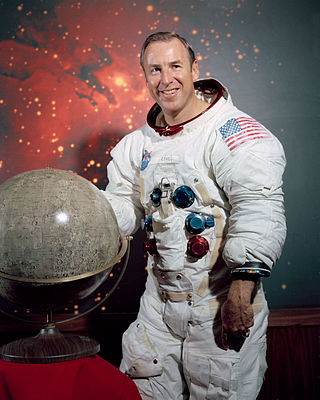
James Arthur Lovell Jr. is an American retired astronaut, naval aviator, test pilot and mechanical engineer. In 1968, as command module pilot of Apollo 8, he became, with Frank Borman and William Anders, one of the first three astronauts to fly to and orbit the Moon. He then commanded the Apollo 13 lunar mission in 1970 which, after a critical failure en route, looped round the Moon and returned safely to Earth.
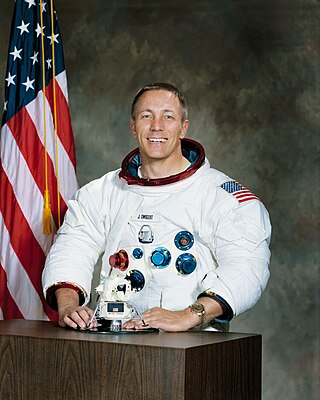
John Leonard Swigert Jr. was an American NASA astronaut, test pilot, mechanical engineer, aerospace engineer, United States Air Force pilot, and politician. In April 1970, as command module pilot of Apollo 13, he became one of 24 astronauts who flew to the Moon. Ironically, due to the "slingshot" route around the Moon they chose to safely return to Earth, the Apollo 13 astronauts flew further away from Earth than any other astronauts before or since, though they had to abort the Moon landing.
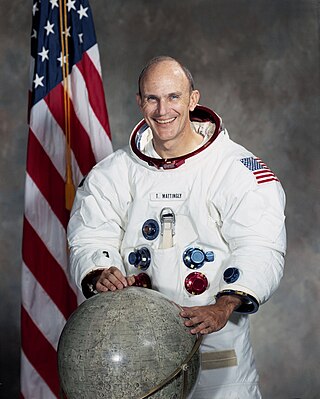
Thomas Kenneth Mattingly II was an American aviator, aeronautical engineer, test pilot, rear admiral in the United States Navy, and astronaut who flew on Apollo 16 and Space Shuttle STS-4 and STS-51-C missions.

For All Mankind is a 1989 documentary film made of original footage from NASA's Apollo program, which successfully prepared and landed the first humans on the Moon from 1968 to 1972. It was directed by Al Reinert, with music by Brian Eno. The film, consisting of footage from Apollo 7 through Apollo 17, was assembled to depict what seems like a single trip to the Moon, highlighting the beauty and otherworldliness of the images by only using audio from the interviews Reinert conducted with Apollo crew members.

Lost Moon: The Perilous Voyage of Apollo 13 is a 1994 non-fiction book by astronaut Jim Lovell and journalist Jeffrey Kluger, about the failed April 1970 Apollo 13 lunar landing mission which Lovell commanded. The book is the basis of the 1995 film adaptation Apollo 13, directed by Ron Howard and starring Tom Hanks as Lovell.

The Lunar Flag Assembly (LFA) was a kit containing a flag of the United States designed to be erected on the Moon during the Apollo program. Six such flag assemblies were planted on the Moon. The nylon flags were hung on telescoping staffs and horizontal bars constructed of one-inch anodized aluminum tubes. The flags were carried on the outside of the Apollo Lunar Module (LM), most of them on the descent ladder inside a thermally insulated tubular case to protect them from exhaust gas temperatures calculated to reach 2,000 °F (1,090 °C). The assembly was designed and supervised by Jack Kinzler, head of technical services at the Manned Spacecraft Center (MSC) in Houston, Texas. Six of the flags were ordered from a government supply catalog and measured 3 by 5 feet ; the last one planted on the Moon was the slightly larger, 6-foot (1.8 m)-wide flag which had hung in the MSC Mission Operations Control Room for most of the Apollo program.

The Lunar basalt 70017 is a Moon rock gathered in 1972 by astronauts Eugene Cernan and Harrison Schmitt on the Apollo 17 mission near their Apollo Lunar Module and then divided into smaller pieces on Earth.

The Astronaut Monument is a monument commemorating the training of Apollo astronauts in northern Iceland in 1965 and 1967. It is located outside the Exploration Museum in Húsavík, and contains the names of 32 Apollo astronauts who were sent to Iceland for training in geology for crewed lunar missions. Fourteen of the trainee astronauts later flew to the Moon, and seven of those conducted geology work on the lunar surface.
